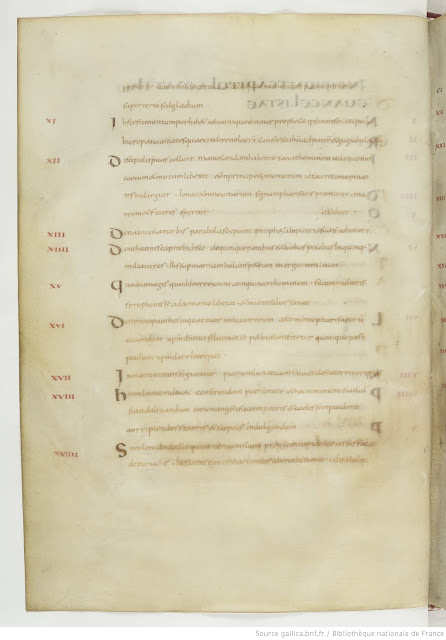The story is often told of how our chapter divisions go back to Stephen Langton in the early thirteenth century. That’s true enough, but it’s worth noting sometimes how close even earlier divisions can get to our current ones. Here’s BnF Ms 268 from the late 8th/early 9th century.
It’s listing the sections of Matthew. I’ve chosen this page because it’s a particularly good example, but it lists ‘chapters’ 11 to 20 (the first x of xx/20 is no longer visible) of Matthew. The surprising thing is that when we look at the content of each chapter, we see that it only misses our current chapter beginnings for ‘chapters’ 16 and 19.
So what Langton really achieved was to produce a standard system where one had not existed previously.
It’s listing the sections of Matthew. I’ve chosen this page because it’s a particularly good example, but it lists ‘chapters’ 11 to 20 (the first x of xx/20 is no longer visible) of Matthew. The surprising thing is that when we look at the content of each chapter, we see that it only misses our current chapter beginnings for ‘chapters’ 16 and 19.
So what Langton really achieved was to produce a standard system where one had not existed previously.
The ninth century BnF Ms 265 is similar:



At this point do you know if there is/are reasonably consistent system(s) of sense unit division to be found in the MSS, whether early or late? Is there any correlation between texttype and placement of divisions?
ReplyDeleteInteresting. I wonder if there were any versification prequels?
ReplyDeleteThe problem is that there are numerous systems, though some which are much more widespread than this one. There are versification prequels to Stephanus, but I'll leave that topic for now.
ReplyDeleteSee Hugh Houghton's article 'Chapter divisions'about the complexity of the chapter division systems in the Latin tradition.
ReplyDeleteH.A.G. Houghton, 'Chapter divisions, Capitula lists, and the old Latin versions of John’ in Revue bénédictine, 121, 2, (2011),p. 316-356.
https://www.brepolsonline.net/doi/pdf/10.1484/J.RB.5.100457
The late 6th century uncial "Gospels of St Augustine (Vulgate ms X, Cambridge, Corpus Christi College, 286), is the earliest representative of Capitula type B. (Houghton, 'Chapter divisions', pp. 328-329). The capitula in BnF Lat 268 (with BnF Lat 256, early 8th century) are also of this type KA B.
DeleteThe study of these paratextual texts can certainly provide valuable data for investigation in textual criticism. See, for example Tommy Wasserman's article in Black/Cerone's "The Pericope of the Adulteress in Contemporary Research", pp. 60-62.
The majority of the mss of KA B includes "de muliere adultera" in the title of chapter 7 (Houghton, p. 329, note 52). Significantly, Vulgate ms X do not mention the PA in chapter 7's title, but the PA is present in the Gospel text.